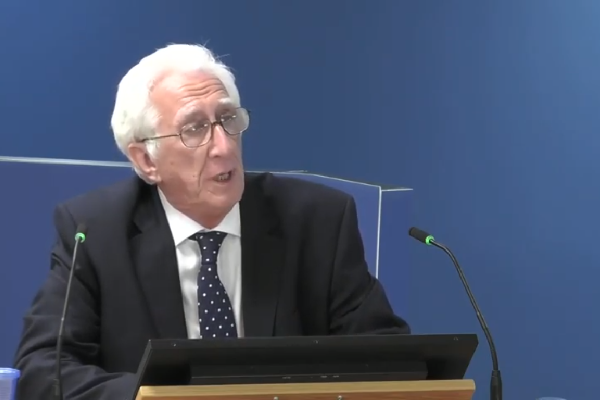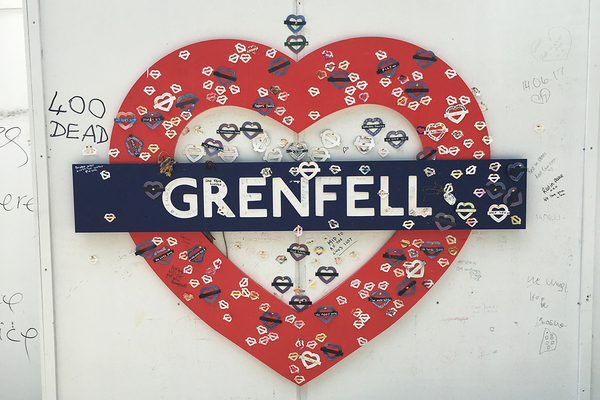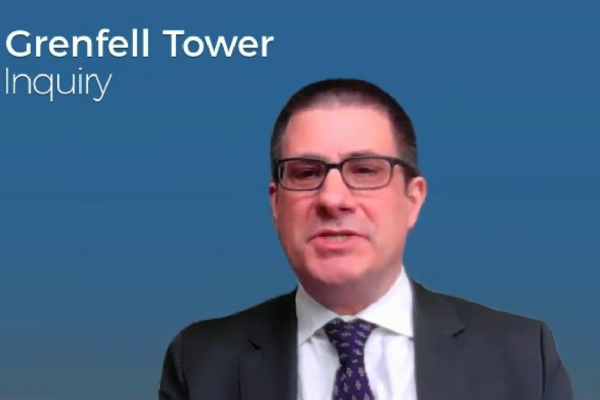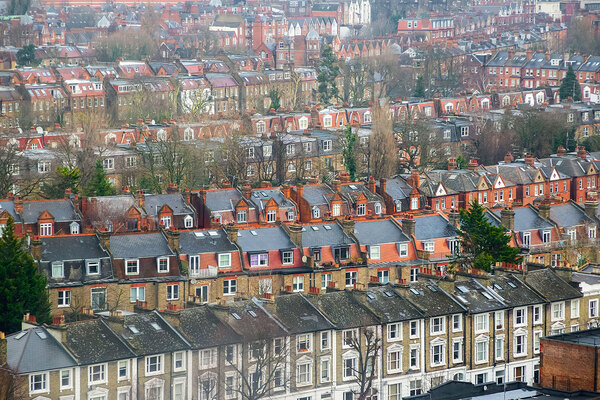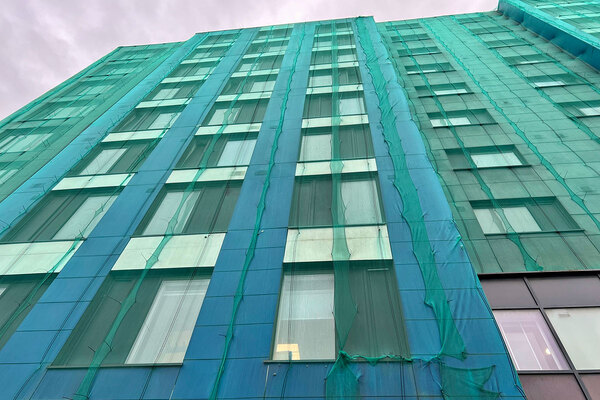Industry did not believe legal obligations for evacuation applied to disabled people in flats, expert tells Grenfell Inquiry
Legal obligations to make provision for safe evacuation of residents were understood by the industry not to apply to disabled people in blocks of flats, an expert witness has told the Grenfell Tower Inquiry.
Colin Todd, a consultancy director who has prepared several key government-endorsed guidance documents for the industry, was today asked about the failure to identify disabled residents of Grenfell Tower and plan for their escape in fire risk assessments carried out before the fire.
It is a legal requirement for all persons to be able to evacuate a building quickly and safely, while official guidance to fire risk assessors says that a “disabled evacuation strategy should not rely on… rescue by the fire and rescue service” and sets clear expectations for their identification.
But asked whether he agreed that evacuation should not be reliant on rescue by firefighters, Mr Todd said: “Other than for disabled people in blocks of flats.”
Mr Todd, who helped write the official guidance, PAS 79, said it was written with commercial premises in mind as making provision for evacuations of disabled people in blocks of flats would not be “practicable” with no staff present.
“Is it right that the fire risk assessment trade regarded it as appropriate to take a different approach to disabled people in high-rise residential buildings from the approach they would take in an office block?” asked counsel to the inquiry Richard Millett QC.
“That would have been the majority opinion, sir, yes,” replied Mr Todd. “Although people with the lens of hindsight will argue about that now. But we trusted ‘stay put’ basically.”
“And is there anything in the legislation or guidance which would justify that majority opinion?” asked Mr Millett.
“I’m not sure I can point to anything, it’s a matter of reasonable practicability, sir,” replied Mr Todd.
Lawyers for the bereaved family members have previously called the Grenfell Tower fire “a landmark act of discrimination against the disabled and vulnerable”, emphasising that 41% of the disabled residents of the tower died during the blaze – a much higher fatality rate than any other group.
Mr Todd accepted that the PAS 79 guidance he wrote applied to residential high rises and that it was never made clear that the passages relating to the identification and evacuation of disabled residents should not have applied in these buildings.
“Can you explain why it was that the fire risk assessment trade was never made aware of what you’re telling us now: namely that these procedures do not or cannot in practice be applied to a residential block of flats?” asked Mr Millett.
“I think that was well understood and had been understood prior to 2006 [when new legislation came into force],” replied Mr Todd. “And so the custom and practice, deficient though it might be, probably continued in truth.”
“Sitting there today don’t you find this rather a surprising debate given that, for example, the Equality Act was passed in 2010?” asked Mr Millett.
“If you build a block of flats correctly, sir, then stay put is extremely favourable to disabled people,” replied Mr Todd.
Calling the Grenfell Tower fire “a dreadful, obscene anomaly”, Mr Todd said that disabled people were generally more likely to die from a fire inside their flats, which made preventative measures within the home more important than evacuation.
Mr Todd’s consultancy produced further industry guidance, endorsed by government, in 2011 which said it is “usually unrealistic” to identify disabled residents and prepare personal emergency evacuation plans (PEEPs) in general needs buildings.
Witnesses from Kensington and Chelsea Tenant Management Organisation (KCTMO) have previously cited this guidance in explaining why they did not generally offer PEEPs to their residents.
Risk assessments prepared for Grenfell Tower by consultant Carl Stokes did consider disability, but simply copied and pasted a statement saying there was “no evidence of any resident” with sensory impairments that would prevent them from hearing a warning of fire into four assessments between 2012 and 2016.
“Was that persistent failure over those years consistent with your expectations of what a reasonably competent fire risk assessor should have done?” asked Mr Millett.
“The risk assessor would not have asked for details of every individual resident but would have said ‘have you any arrangements in hand for giving assistance to disabled people’,” Mr Todd replied. “And I would expect them to have some high-level generic information. But no greater detail than that.”
Mr Todd was also asked about other instances of cutting and pasting in Mr Stokes’ assessments – including his statement in several assessments that Grenfell had pigeon netting on balconies that did not present a fire risk. Grenfell had neither balconies nor pigeon netting.
Mr Todd’s expert report had called Mr Stokes’ assessments “meticulous” but had said he had “slight concerns” about this practice of cutting and pasting from reviews of other buildings.
“Would you seriously describe as meticulous the work of a fire risk assessor who cut text from an [assessment] for building A, and pasted that into an [assessment] for building B where it was completely inapposite?” asked Mr Millett.
“He went into incredible detail, but you then have to sort out which bits of that detail was something of a cut and paste and which was specific and unique to the building,” said Mr Todd.
“Why is it something that only gives you slight concern? It’s very bad practice, isn’t it?” said Mr Millett.
“Perhaps I would be willing to delete the word ‘slight’ if you wish, sir,” said Mr Todd.
Earlier, Mr Todd was asked about an email exchange from December 2016, six months before the Grenfell Tower fire, when he received an email from a senior firefighter in the London Fire Brigade, asking for advice regarding risk-assessing dangerous cladding systems.
Mr Todd responded, saying that he had spoken with Brian Martin, a senior civil servant within the Ministry of Housing, Communities and Local Government (MHCLG), and they were considering requiring checks for buildings taller than 18 metres “where there is good reason to suspect that external cladding could readily support external fire spread”. Such a change was not made before the fire.
The email – which had not previously been released – is the latest in a string of evidence showing that warnings about cladding fires reached central government before the tragedy in June 2017.
Asked about the email today, Mr Todd said: “I said why don’t we have a conference call with Brian Martin at MHCLG, who I think it’s no secret is a personal friend, let’s see if we can put our heads together and come up with something that we could keep in mind for, for the future editions of [the guidance].”
Mr Martin is due to give extensive evidence to the inquiry when it turns to the role of central government in the autumn.
In response to questions from inquiry chair Sir Martin Moore-Bick, Mr Todd also told the inquiry that the 18-metre line for high-rise buildings was “an arbitrary limit based on historical considerations”.
He said he did not think questioning the safety of cladding systems below that height threshold would be sensible because the “practical effect” of government guidance was to place no restrictions on the use of combustible materials.
The government is currently embroiled in difficulty over what to do about the tens of thousands of buildings below this height threshold that have combustible materials fitted to their walls.
Last week, housing secretary Robert Jenrick beseeched lenders not to ask for assessments of the safety of the facades of these buildings, insisting there was “no evidence” of a systemic risk from fire.
The inquiry continues with further evidence from Mr Todd tomorrow.
Sign up for our weekly Grenfell Inquiry newsletter
Each week we send out a newsletter rounding up the key news from the Grenfell Inquiry, along with the headlines from the week
Already have an account? Click here to manage your newsletters
